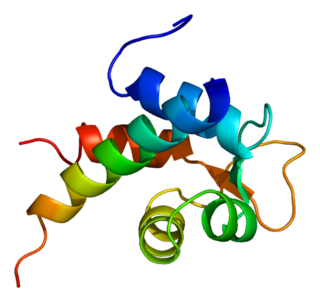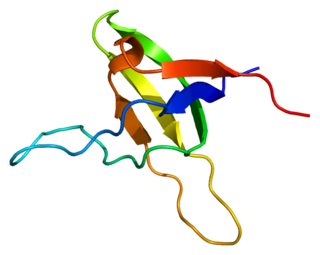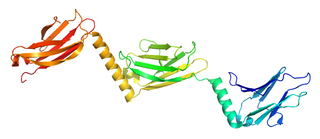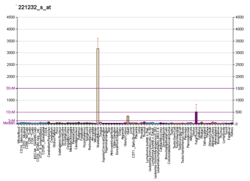
Titin is a protein that in humans is encoded by the TTN gene. Titin is a giant protein, greater than 1 µm in length, that functions as a molecular spring that is responsible for the passive elasticity of muscle. It comprises 244 individually folded protein domains connected by unstructured peptide sequences. These domains unfold when the protein is stretched and refold when the tension is removed.

The ankyrin repeat is a 33-residue motif in proteins consisting of two alpha helices separated by loops, first discovered in signaling proteins in yeast Cdc10 and Drosophila Notch. Domains consisting of ankyrin tandem repeats mediate protein–protein interactions and are among the most common structural motifs in known proteins. They appear in bacterial, archaeal, and eukaryotic proteins, but are far more common in eukaryotes. Ankyrin repeat proteins, though absent in most viruses, are common among poxviruses. Most proteins that contain the motif have four to six repeats, although its namesake ankyrin contains 24, and the largest known number of repeats is 34, predicted in a protein expressed by Giardia lamblia.

Myomesin is a protein family found in the M-line of the sarcomere structure. Myomesin has various forms throughout the body in striated muscles with specialized functions. This includes both slow and fast muscle fibers. Myomesin are made of 13 domains including a unique N-terminal followed by two immunoglobulin-like (Ig) domains, five fibronectin type III (Fn) domains, five more Ig domains. These domains all promote binding which indicates that myomesin is regulated through binding.

Nebulette is a cardiac-specific isoform belonging to the nebulin family of proteins. It is encoded by the NEBL gene. This family is composed of 5 members: nebulette, nebulin, N-RAP, LASP-1 and LASP-2. Nebulette localizes to Z-discs of cardiac muscle and appears to regulate the length of actin thin filaments.

Alpha-actinin-2 is a protein which in humans is encoded by the ACTN2 gene. This gene encodes an alpha-actinin isoform that is expressed in both skeletal and cardiac muscles and functions to anchor myofibrillar actin thin filaments and titin to Z-discs.

β-Tropomyosin, also known as tropomyosin beta chain is a protein that in humans is encoded by the TPM2 gene. β-tropomyosin is striated muscle-specific coiled coil dimer that functions to stabilize actin filaments and regulate muscle contraction.

Telethonin, also known as Tcap, is a protein that in humans is encoded by the TCAP gene. Telethonin is expressed in cardiac and skeletal muscle at Z-discs and functions to regulate sarcomere assembly, T-tubule function and apoptosis. Telethonin has been implicated in several diseases, including limb-girdle muscular dystrophy, hypertrophic cardiomyopathy, dilated cardiomyopathy and idiopathic cardiomyopathy.

Troponin I, fast skeletal muscle is a protein that in humans is encoded by the TNNI2 gene.

Obscurin is a protein that in humans is encoded by the OBSCN gene. Obscurin belongs to the family of giant sarcomeric signaling proteins that includes titin and nebulin. Obscurin is expressed in cardiac and skeletal muscle, and plays a role in the organization of myofibrils during sarcomere assembly. A mutation in the OBSCN gene has been associated with hypertrophic cardiomyopathy and altered obscurin protein properties have been associated with other muscle diseases.

Ankyrin repeat domain-containing protein 1, or Cardiac ankyrin repeat protein is a protein that in humans is encoded by the ANKRD1 gene also known as CARP. CARP is highly expressed in cardiac and skeletal muscle, and is a transcription factor involved in development and under conditions of stress. CARP has been implicated in several diseases, including dilated cardiomyopathy, hypertrophic cardiomyopathy, and several skeletal muscle myopathies.

Nebulin-related-anchoring protein(N-RAP) is a protein that in humans is encoded by the NRAP gene. N-RAP is a muscle-specific isoform belonging to the nebulin family of proteins. This family is composed of 5 members: N-RAP, nebulin, nebulette, LASP-1 and LASP-2. N-RAP is involved in both myofibrillar myogenesis during development and cell-cell connections in mature muscle.

E3 ubiquitin-protein ligase TRIM63, also known as "MuRF1", is an enzyme that in humans is encoded by the TRIM63 gene.

Myopalladin is a protein that in humans is encoded by the MYPN gene. Myopalladin is a muscle protein responsible for tethering proteins at the Z-disc and for communicating between the sarcomere and the nucleus in cardiac and skeletal muscle

Myomesin-1 is a protein that in humans is encoded by the MYOM1 gene. Myomesin-1 is expressed in muscle cells and functions to stabilize the three-dimensional conformation of the thick filament. Embryonic forms of Myomesin-1 have been detected in dilated cardiomyopathy.

Ankyrin repeat domain-containing protein 17 is a protein that in humans is encoded by the ANKRD17 gene.

Ankyrin 1, also known as ANK-1, and erythrocyte ankyrin, is a protein that in humans is encoded by the ANK1 gene.

Ankyrin repeat domain-containing protein 23 is a protein that in humans is encoded by the ANKRD23 gene.

Myomesin-2, also known as M-protein is a protein that in humans is encoded by the MYOM2 gene. M-protein is expressed in adult cardiac muscle and fast skeletal muscle, and functions to stabilize the three-dimensional arrangement of proteins comprising M-band structures in a sarcomere.
Ankyrin-2, also known as Ankyrin-B, and Brain ankyrin, is a protein which in humans is encoded by the ANK2 gene. Ankyrin-2 is ubiquitously expressed, but shows high expression in cardiac muscle. Ankyrin-2 plays an essential role in the localization and membrane stabilization of ion transporters and ion channels in cardiomyocytes, as well as in costamere structures. Mutations in ANK2 cause a dominantly-inherited, cardiac arrhythmia syndrome known as long QT syndrome 4 as well as sick sinus syndrome; mutations have also been associated to a lesser degree with hypertrophic cardiomyopathy. Alterations in ankyrin-2 expression levels are observed in human heart failure.

Ankyrin repeat domain 11 is a protein that in humans is encoded by the ANKRD11 gene.




















